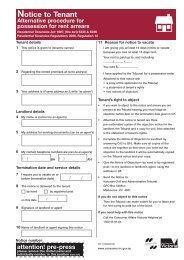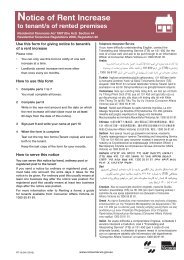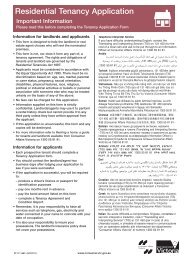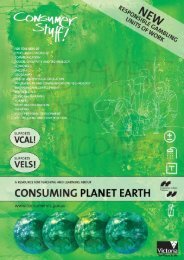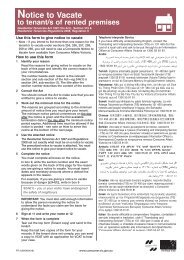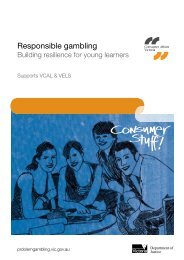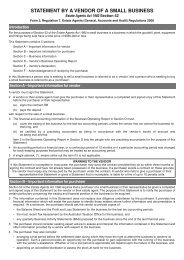Consumer Stuff for kids (PDF, 6.2 MB) - Consumer Affairs Victoria
Consumer Stuff for kids (PDF, 6.2 MB) - Consumer Affairs Victoria
Consumer Stuff for kids (PDF, 6.2 MB) - Consumer Affairs Victoria
Create successful ePaper yourself
Turn your PDF publications into a flip-book with our unique Google optimized e-Paper software.
104<br />
• Students use the 3 step definition strategy to define terms such as in<strong>for</strong>mative advertising, persuasive<br />
advertising, target audience and product branding.<br />
• Students draw a variety of commonly identifiable logos found in the school, local and wider community.<br />
• Students compile a list of the 20 most desirable brands according to children their age.<br />
• Ask the students to discuss “Is this advertising?”<br />
w The company logo on a football/netball.<br />
w A brand name in big letters on a T-shirt.<br />
w A campaign to wear a hat and sunscreen to avoid sunburn.<br />
w A famous actor drinks a can of well known soft drink in a film.<br />
w A sports logo on a tennis player’s T-shirt.<br />
• Students revise their definition of advertising and make changes based on class discussion.<br />
• Students use a Y chart to brainstorm what advertising Looks like, Sounds like and Feels like.<br />
• Students use the Think, Pair, Share strategy to compile a list of questions they would like to ask guest<br />
speakers involved in the advertising industry. In this strategy ‘think’ time on a given topic or question is<br />
allowed. Students then pair and share their response.<br />
• Apply the 5 Whys strategy to Why do we have advertising?<br />
w “So consumers buy stuff (goods and services)” Why?<br />
w “Because shops, retailers need to sell stuff to make money” Why?<br />
w “Because shopkeepers and shop-owners need money to pay their workers and buy more<br />
goods and services to sell.” Why?<br />
w “Because without workers, goods and services shops/retailers would go out of business and be<br />
unable to make a living.”<br />
Finding out<br />
• Invite experts (guest speakers in the field of marketing, graphic design) to discuss their work and<br />
answer questions the students have compiled.<br />
• View TV advertisements taped during programs targeting children and compare with advertisements<br />
aired during other times such as the nightly news or during sports shows. What did you notice about<br />
the advertisements during the two shows?<br />
• Discuss with students whether they have ever been affected by false advertising?<br />
• Explain that manufacturers create jingles or catchy sayings to encourage customers to think of their<br />
products. Complete a matching activity where students match the food jingle with the food product.<br />
w Aussie <strong>kids</strong> are ................ (Weetbix)<br />
w Oh what a feeling ............. (Toyota)<br />
• Listen to taped jingles to find out what they are advertising and ask students to draw the images these<br />
jingles create in their minds.<br />
• Brainstorm stores and companies that use strategies such as up-selling or encourage consumers to buy<br />
the newest or most popular model.<br />
• Advertisements also try to positively influence our behaviour and lifestyle. Use the internet to find a<br />
variety of these campaigns and organisations ie:<br />
The anti cancer council - slip, slop, slap at www.cancer.org.au or www.cancervic.org.au,<br />
The Australian Guide to Healthy Eating at www.health.gov.au,<br />
Go For Your life at www.go<strong>for</strong>yourlife.vic.gov.au,<br />
Go <strong>for</strong> 2 and 5 at www.go<strong>for</strong>2and5.com.au<br />
• Check out www.admongo.gov. It's an interactive online advertising game.<br />
Test your advertising sleuth skills!<br />
CONSUMER AFFAIRS VICTORIA NEED CONSUMER HELP? 1300 55 81 81 www.consumer.vic.gov.au



